This article was originally published in Grass Roots Magazine No 116 August/ September 1996
Wheat has been one of our primary exports for years and is still produced in vast quantities by Australian farmers today. It is very good for us providing an excellent balance of protein, carbohydrates, fibre, vitamins and minerals. (Yes I know some have allergy issues but this is still basically true). It is ridiculously cheap for what it is, with a 50 kilogram bag of wheat grain, or berries as they are sometimes called, costing less than $20 (1996 prices) although organic or biodynamic wheat will cost more ($89.95 per 20kg bag, 2024 price). Most of us consume our daily ration as bread, either homemade or shop bought, but there is another food that is easily produced from wheat berries – bulgur, also called burgul.
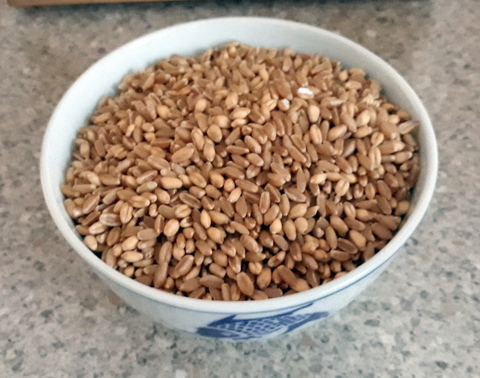
Wheat berries, the raw material
Originally produced in the Middle East, and much used in Middle Eastern cuisine, bulgur is a way of making wheat berries easier to digest and more palatable. There is also the convenience factor as bulgur is much quicker to cook than unprocessed wheat and its final form is more insect resistant that conventional wheat flour.
There are a number of steps to making bulgur and the product of each step is edible in its own right, able to be used without further processing in many interesting ways. Depending on the books you read, directions for making bulgur will vary from those given below, but I have found these methods to work for us.
Method
Steaming
The raw wheat berries are steamed to make them soft.
This is done by placing one cup of wheat, one cup of water and one teaspoon of salt in a small pot. The small pot is then placed, uncovered, on a rack or other support in a larger pot which contains some water. The lid is then placed on the larger pot and the whole set up put on high heat for 15 minutes, after which the heat is reduced to ‘simmer’ and left until the wheat has absorbed all the water. This may take up to an hour or more.
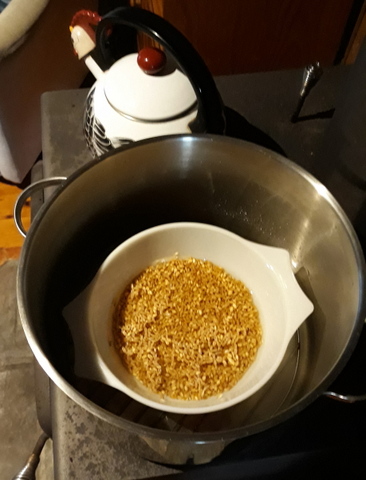
Steaming on the woodfired stove (lid removed)
The product is soft chewy wheat berries and at this stage they make an excellent alternative to rice in most recipes. It can also be used as a breakfast cereal with the addition of milk, sugar, fruit, yoghurt or whatever. It is a highly nutritious and breakfast cereals don’t come much cheaper than this. At this stage the ‘pre-bulgur’ will keep for a couple of weeks in a covered container in the refrigerator, so it is possible to cook up a week’s breakfasts in one go if you want to.
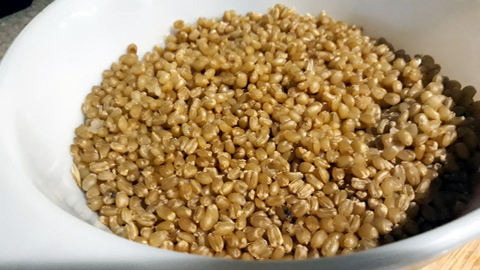
Steamed wheat berries
If you don’t like the amount of energy used in the above method, another way of doing it is to put the wheat, water and salt into a pot and boil it for five minutes. Then pour the contents into a vacuum flask (or other stored heat cooker), preferably one with a wide mouth, cap it an leave it overnight. The result is the same as the previous method but the wheat is cooked in its own stored heat, and it can be eaten, still warm, the next morning. Make sure there is planty of room for expansion in the flask, because one cup of raw wheat makes three cups of cooked ‘pre-bulgur’.
Parching
The steamed what berries are then parched.
This can be done under the griller, in the oven or in a frypan on the top of the stove. However you choose to do it, the steamed what berries are laid out in a single layer and then heat is applied. The wheat berries will ‘pop’ in a similar manner to popcorn, but without the increase in size, so you need to keep an eye on them to prevent any escaping. The grains will also need to be stirred every so often to ensure that they parch evenly. When the berries haver turned medium brown to dark brown, they will be ready.
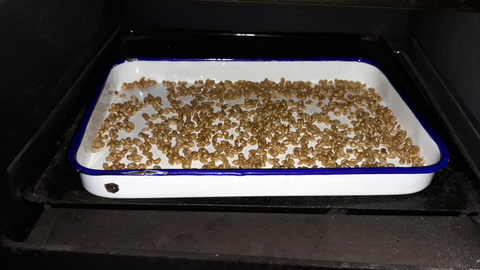
Parching in the oven
At this stage it is worth chewing a few of the parched berries to taste their flavour, it is very similar to puffed wheat (funny about that!) and quite palatable. The parched wheat berries actually make a very cheap, palatable and nutritious breakfast cereal when milk and sugar are added. The can also be eaten as they are, or with the addition of a small amount of sweetener such as honey, as a TV snack. The parched berries will keep a number of months but should be stored in a sealed container or they will go a bit soggy and lose their crunch.

Wheat berries, steamed and parched
Grinding
The Parched Berries are then coarsely ground.
This may be done by setting your wheat grinder (if you have one) on ‘coarse’ and running the berries through, they should come out the other end looking like little lumps rather than flour. If you don’t have a wheat grinder the same effect can be achieved by putting the grains into a blender or food processor and running it on high speed for a few seconds. Alternatively, the bulgur can be made by running the grains through hand powered meat mincer, which will do the job nicely.
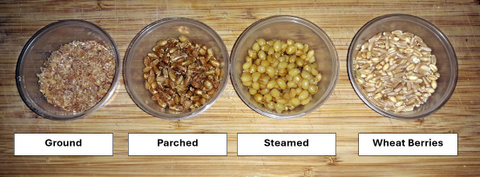
The Bulgur is now finished and will store for months if kept dry, plus it seems to be particularly resistant to insect attack. In its final form the bulgur can be used in soups, as an ingredient of stuffing for meats or vegetables, in the form of a pilaf instead of rice, or as a base for the tasty Lebanese salad, tabouleh. To make tabouleh the bulgur needs to be cooked first, this is done by adding four cups of boiling water to each cup of bulgur and letting it stand for about two hours. The bulgur is then strained and squeezed with the hands to remove any excess water, and then it is combined with cooked chickpeas, parsley, mint, spring onions, tomatoes, lemon juice, olive oil and salt and pepper.
Many vegetarian or Middle Eastern cookbooks have tasty and interesting recipes that show you how to use bulgur, so why not have a bash at bulgur making? It is easy, cheap, nutritious and best of all……fun!


